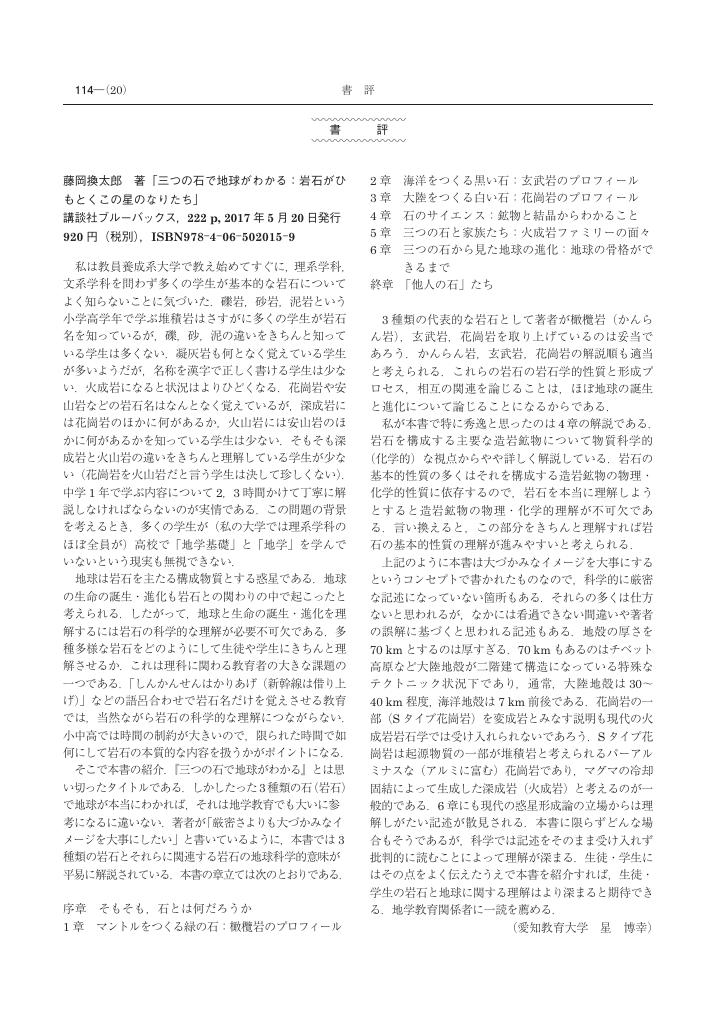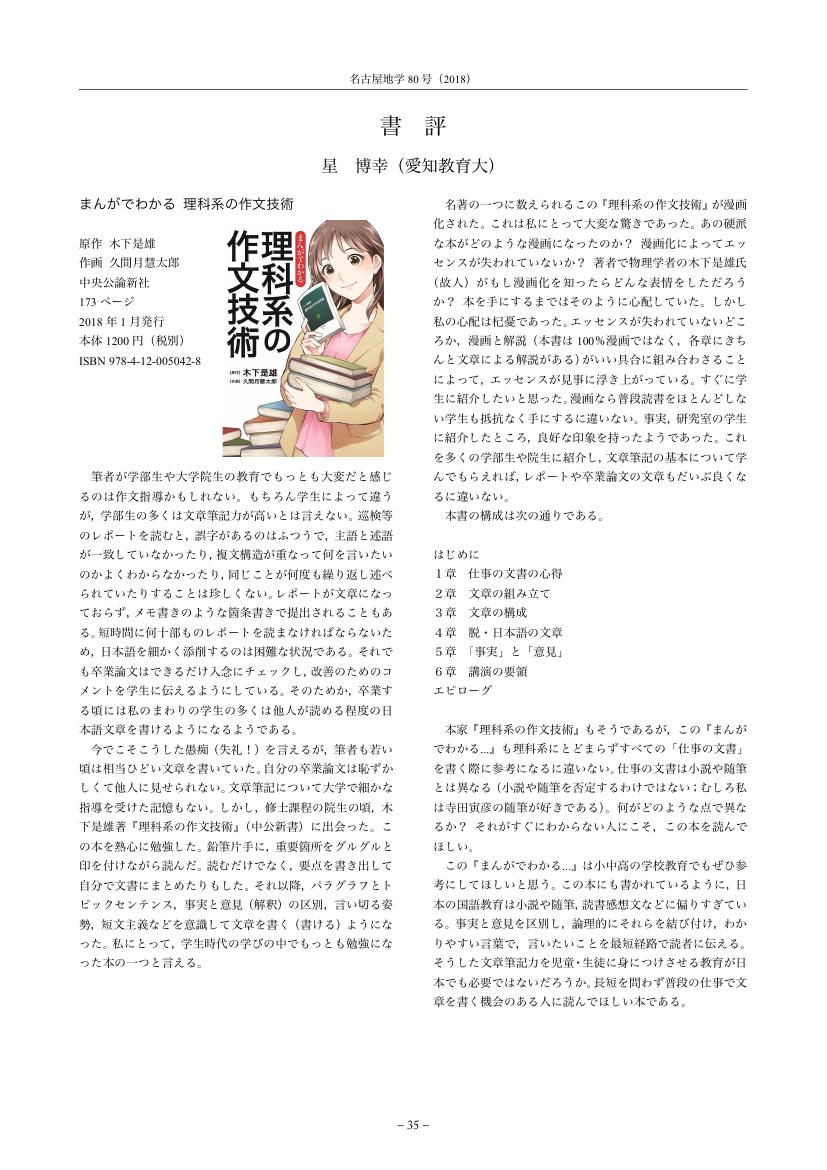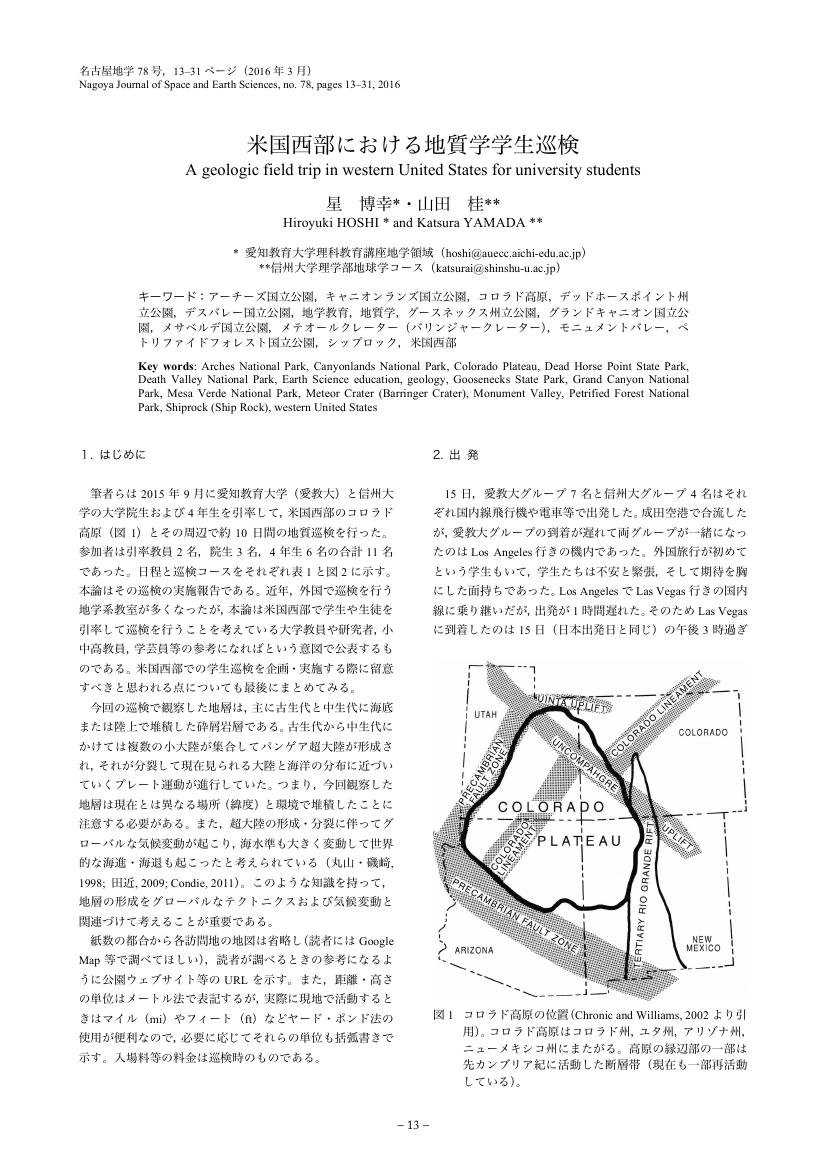72 0 0 0 OA 野外実習レポートをどう書くか
- 著者
- 星 博幸
- 出版者
- 名古屋地学会
- 雑誌
- 名古屋地学 (ISSN:13450514)
- 巻号頁・発行日
- vol.82, pp.17-23, 2020 (Released:2020-04-05)
- 参考文献数
- 13
20 0 0 0 OA 磁極と地磁気極
- 著者
- 星 博幸 山本 裕二 渋谷 秀敏
- 出版者
- 日本地学教育学会
- 雑誌
- 地学教育 (ISSN:00093831)
- 巻号頁・発行日
- vol.68, no.4, pp.197-203, 2016-06-30 (Released:2017-05-31)
- 参考文献数
- 30
教科書等で混同されることがある「磁極」と「地磁気極」について解説する.磁極は地磁気の伏角が+90°(磁力線が鉛直下向き)または-90°(磁力線が鉛直上向き)の地点のことである.一方,地磁気極は磁軸(地磁気の姿を最もよく近似する双極子を地球中心に仮定した場合の双極子軸の延長)が地表と交わる地点を言う.似た用語は紛らわしく混乱の元にも思えるが,その違いは地磁気の本質と深く関わっている.
17 0 0 0 OA 長野県中部に分布する守屋層火山岩類(中新統)のジルコンU-Pb年代とその層序学的意義
- 著者
- 星 博幸 岩野 英樹 檀原 徹
- 出版者
- 一般社団法人 日本地質学会
- 雑誌
- 地質学雑誌 (ISSN:00167630)
- 巻号頁・発行日
- vol.128, no.1, pp.143-152, 2022-07-06 (Released:2022-07-06)
- 参考文献数
- 46
守屋層は北部フォッサマグナ南縁部の中新世古環境や伊豆弧衝突に関連した地殻運動を記録していると推定されるが,その上部を構成する変質火山岩類の年代がよくわかっていなかった.今回,守屋層最上部の唐沢川酸性火山岩部層から15.5±0.2<sub>(2σ)</sub> MaのジルコンU-Pb年代を得た.この結果より,本部層の火山岩類の形成は15.5 Ma頃だったと考えられる.守屋山地域の火山活動はN8帯の下限年代である17.0 Ma以降に始まり15.5 Ma頃まで継続したと考えられ,15.5 Ma以降も火山活動が継続していた可能性はある.守屋層は下部の砕屑岩部分が北部フォッサマグナの内村層に対比されているが,上部の火山岩類も含む守屋層全体が内村層に対比可能と考えられる.この火山岩類の活動は設楽火山岩類の主要活動(約15-13 Ma)に先立って起こったが,設楽火山岩類の一部である津具火山岩類の活動とは同時期だった可能性がある.
16 0 0 0 OA 東北日本,朝日山地南縁に分布する中新統の地質と古地磁気および地殻回転時期
- 著者
- 星 博幸 山口 尚之 吉田 武義
- 出版者
- 一般社団法人 日本地質学会
- 雑誌
- 地質学雑誌 (ISSN:00167630)
- 巻号頁・発行日
- vol.129, no.1, pp.551-566, 2023-11-03 (Released:2023-11-03)
- 参考文献数
- 81
One of the tectonic features that characterizes the Miocene geology of Northeast Japan is crustal block rotation during and after the opening of the back-arc Sea of Japan. However, the spatial and temporal characteristics of this block rotation are not well understood. A better understanding of this block rotation would shed light on the Miocene tectonic evolution of Northeast Japan. We carried out geological mapping and geochronological and paleomagnetic analyses to determine the timing of block rotation on the southern margin of the Asahi Mountains, on the back-arc side of Northeast Japan. We present a geological map and chronostratigraphic model of the lower-middle Miocene strata and redefine two lower Miocene formations. K-Ar dates show that andesite dikes and sills were intruded at ~15 Ma. The crust beneath the study area was rotated counterclockwise relative to the Asian continent, although it was broken into blocks with varying degrees of rotation. In the eastern part of the study area, counterclockwise rotation of ~40°-50° relative to the continent occurred between 17.5 and 15 Ma. Rotation probably did not occur during the earlier development of intra-arc rift basins. The timing of the rotation overlaps with that of the formation of the Myozawa Syncline, which is a growth fold that formed during the deposition of shallow marine sediments during the latest early Miocene. Complex block rotation in a possible dextral transtensional regime in the Asahi Mountains was likely confined to a period of 2 Myr between 17 and 15 Ma. This block rotation probably occurred during the late stage of the opening of the back-arc Sea of Japan.
10 0 0 0 OA 中新統,師崎層群と瑞浪層群に含まれる軽石質凝灰岩の対比
- 著者
- 古川 邦之 谷 健一郎 金丸 龍夫 星 博幸
- 出版者
- 一般社団法人 日本地質学会
- 雑誌
- 地質学雑誌 (ISSN:00167630)
- 巻号頁・発行日
- vol.129, no.1, pp.325-340, 2023-04-14 (Released:2023-04-14)
- 参考文献数
- 47
- 被引用文献数
- 1
中部地方の下部中新統である,師崎層群日間賀層および山海層下部と瑞浪層群明世層狭間部層における軽石質凝灰岩の対比について検討した.日間賀層および山海層下部の試料からはそれぞれ,狭間部層の年代と調和的な17.87±0.75 Maおよび17.36±0.40 MaのジルコンU-Pb年代が得られた.また日間賀層の古地磁気は山海層下部や狭間部層と同じく逆極性であった.つまりこれら3層はいずれも古地磁気年代のクロンC5Drに相当すると結論できる.EPMA分析から,山海層下部と狭間部層の試料に含まれる火山ガラスは組成変化図において一連のトレンドを示し,3層に含まれる斜長石組成は類似していた.つまりこれら3層の火山砕屑物は同一のマグマ供給系を起源とすると考えられる.以上の結果と古水深から,本研究対象の師崎層群の軽石質凝灰岩は,狭間部層の火山砕屑物が海底を流下して堆積したと考えられる.
8 0 0 0 OA 校内の屋外岩石を使用した風化作用の教材化:小学校での授業実践と教育効果の検証
- 著者
- 角野 真由 星 博幸
- 出版者
- 愛知教育大学
- 雑誌
- 愛知教育大学研究報告. 自然科学編 (ISSN:18845169)
- 巻号頁・発行日
- vol.71, pp.59-66, 2022-03-01
6 0 0 0 OA 解説:地磁気(地球磁場)の逆転
- 著者
- 星 博幸
- 出版者
- 名古屋地学会
- 雑誌
- 名古屋地学 (ISSN:13450514)
- 巻号頁・発行日
- vol.80, pp.31-34, 2018 (Released:2019-03-05)
- 参考文献数
- 15
4 0 0 0 OA 藤岡換太郎 著「三つの石で地球がわかる:岩石がひもとくこの星のなりたち」
- 著者
- 星 博幸
- 出版者
- 日本地学教育学会
- 雑誌
- 地学教育 (ISSN:00093831)
- 巻号頁・発行日
- vol.70, no.3, pp.114, 2018-01-31 (Released:2019-01-01)
- 著者
- 星 博幸 川上 裕 岩野 英樹 檀原 徹
- 出版者
- 一般社団法人 日本地質学会
- 雑誌
- 地質学雑誌 (ISSN:00167630)
- 巻号頁・発行日
- vol.128, no.1, pp.229-237, 2022-11-03 (Released:2022-11-03)
- 参考文献数
- 55
- 被引用文献数
- 3
紀伊半島の四万十付加体竜神コンプレックスの堆積年代はこれまで主に半島西部及び中央部で調査され,半島東部からは年代データの報告がなかった.筆者らは半島東部の竜神コンプレックス寒川ユニットに挟在する珪長質細粒凝灰岩からジルコンを分離し,68.1±0.4(2σ)MaのU-Pb年代と13.3±1.6(2σ)MaのFT年代を決定した.U-Pb年代はマーストリヒチアン期後期の堆積を示唆し,これは半島西部及び中央部で放射年代と放散虫化石から推定されている堆積年代と類似する.一方,FT年代は試料採取地周辺に分布する熊野酸性岩類や大峯酸性岩類などの中期中新世火成岩類の放射年代と類似するため,中期中新世火成岩類の熱影響によってリセットされた年代と考えられる.
4 0 0 0 OA 書評:まんがでわかる 理科系の作文技術(木下是雄・久間月慧太郎)
- 著者
- 星 博幸
- 出版者
- 名古屋地学会
- 雑誌
- 名古屋地学 (ISSN:13450514)
- 巻号頁・発行日
- vol.80, pp.35, 2018 (Released:2019-03-05)
3 0 0 0 OA 愛知県蒲郡市竹島に分布する領家花崗岩類の帯磁率
- 著者
- 星 博幸 森里 真希
- 出版者
- 名古屋地学会
- 雑誌
- 名古屋地学 (ISSN:13450514)
- 巻号頁・発行日
- vol.81, pp.15-20, 2019 (Released:2019-03-21)
- 参考文献数
- 34
愛知県蒲郡市竹島は,花崗岩質岩石(苦鉄質岩を含む)の露頭および転石に残された矢穴と刻印の存在から名古屋城石垣採石丁場の一つと考えられている。それを自然科学的手法により検証し名古屋城築城の実態解明に資する基礎データを得るために,筆者らは竹島を構成する花崗岩質岩石の帯磁率(初磁化率または初帯磁率)を測定した。竹島の帯磁率は最小値(0.05×10−3 SI)と最大値(56.3×10−3 SI)の差が3桁にも達する幅広い変化を示す。大まかに見れば片状花崗閃緑岩よりも苦鉄質岩のほうが高い帯磁率を示す傾向があるが,苦鉄質岩でも0.5×10−3 SI以下のやや低い値を示す場所がある。地理的に見ると,西側海岸の中央部付近と東側海岸の中央部付近の岩石が高い帯磁率を示す傾向があり,その高帯磁率帯のトレンド(WSW–ENE)は苦鉄質岩の分布トレンドや島北半部の片状構造の一般走向と斜交している。島の南端~南東海岸の岩石は比較的低い帯磁率を示す傾向がある。露頭に多数の矢穴が穿たれている島北西部の海岸露頭では帯磁率が1×10−3~3×10−3 SIの範囲であった。
3 0 0 0 OA 編集後記
- 著者
- 星 博幸
- 出版者
- 名古屋地学会
- 雑誌
- 名古屋地学 (ISSN:13450514)
- 巻号頁・発行日
- vol.83, pp.36, 2021 (Released:2021-03-06)
2 0 0 0 OA アパタイト微量元素組成を用いた紀伊半島の中期中新世カルデラ噴出物の対比
- 著者
- 高嶋 礼詩 和田 穣隆 星 博幸 新正 裕尚 工藤 崇 西 弘嗣
- 出版者
- 一般社団法人 日本地質学会
- 雑誌
- 日本地質学会学術大会講演要旨 第125年学術大会(2018札幌-つくば) (ISSN:13483935)
- 巻号頁・発行日
- pp.162, 2018 (Released:2019-08-16)
【災害のためプログラム中止】 平成30年北海道胆振東部地震により学術大会のプログラムが大幅に中止となりました.中止となったプログラムの講演要旨については,著者のプライオリティ保護の見地からJ-STAGEに公開し,引用可能とします.ただし,学術大会においては専門家による議論には供されていませんので「災害のためプログラム中止」との文言を付記します.(日本地質学会行事委員会)
2 0 0 0 OA 関東対曲構造の形成はいつ始まったか?
- 著者
- 星 博幸
- 出版者
- 一般社団法人 日本地質学会
- 雑誌
- 地質学雑誌 (ISSN:00167630)
- 巻号頁・発行日
- vol.124, no.10, pp.805-817, 2018-10-15 (Released:2019-01-24)
- 参考文献数
- 124
- 被引用文献数
- 10 10
筆者は「関東対曲構造の形成はいつ始まったか」という問題について主に地質と古地磁気の両面から最近の研究をレビューし,現状の到達点について整理した.伊豆衝突帯の櫛形山地塊の地質より,伊豆弧と本州弧の衝突は17Ma頃には始まりつつあったと考えられる.対曲構造の東西両翼から得られた古地磁気データは,対曲構造の形成が約17Maから15Maまでの間のある時期に始まった可能性が高いことを示す.地質から推定される年代と古地磁気から推定される年代が整合することから,約17Maから15Maまでの間のある時期に本州弧と伊豆弧の衝突が始まり,衝突開始と同時に対曲構造の形成も始まったと考えられる.伊豆弧衝突と対曲構造の形成開始を約15Maと考える研究者が多かったが,実際には15Maには衝突も対曲構造形成もすでに始まっていたようだ.小論では対曲構造形成に関連する検証可能な仮説についてもいくつか紹介した.
2 0 0 0 OA 米国西部における地質学学生巡検
- 著者
- 星 博幸
- 雑誌
- JpGU-AGU Joint Meeting 2020
- 巻号頁・発行日
- 2020-03-13
Geological and paleomagnetic data suggest that the Japan Sea backarc basin has a two-phase opening history. The first phase may have been relatively slow opening that began in the Eocene or early Oligocene, and the second phase was relatively fast opening occurring in the early Miocene. Paleomagnetic data reported from the Japan arc over the past 40 years show that the second phase was accompanied by differential arc rotation, namely, clockwise rotation of the southwestern lithospheric sliver of the arc (SW Japan) and counterclockwise rotation of the northeastern sliver (NE Japan). However, it is uncertain whether the first phase was also accompanied by differential arc rotation. Here, new paleomagnetic data are presented to address this issue. In this study, Paleocene (~60 Ma) andesite dikes were sampled at 17 sites in the Toki-Mizunami area in SW Japan. These dikes vertically or subvertically intrude a late Cretaceous (~70 Ma) granite batholith and comprise an ENE-striking dike swarm. Stepwise demagnetization experiments were performed on all samples for obtaining characteristic remanent magnetization (ChRM) components. As a result, site-mean directions of ChRM components were determined for 14 sites. Thermal demagnetization of natural remanent magnetization (NRM) and isothermal remanent magnetization (IRM) shows that magnetite is the main magnetic carrier. Comparison of the site-mean directions with the anisotropy of magnetic susceptibility (AMS) suggests that the influence of the preferred orientation of magnetic particles upon the site-mean directions is absent or negligible. Although the site-mean directions display a small dispersion, the presence of dual polarities suggests that the dike emplacement extended over a set of normal and reverse polarity chrons. The overall mean direction of the 14 site-means is therefore interpreted to be a time-averaged paleomagnetic direction at ~60 Ma. It is deflected ~57° clockwise of an expected paleomagnetic direction calculated from a late Cretaceous paleomagnetic pole for the North China Block in the Asian continent, and the amount of clockwise deflection is larger than that (~44°) reported for early Miocene sediments in the Toki-Mizunami area. Therefore, small (~10–15°) clockwise rotation occurred in the study area between the Paleocene and the early Miocene. It is likely that this small rotation is associated with the early opening of the Japan Sea.
1 0 0 0 OA 石川県, 戸室火山溶岩ドームの岩石磁気と古地磁気
- 著者
- 星 博幸 石渡 明
- 出版者
- 一般社団法人 日本地質学会
- 雑誌
- 地質学雑誌 (ISSN:00167630)
- 巻号頁・発行日
- vol.110, no.9, pp.536-544, 2004 (Released:2005-01-07)
- 参考文献数
- 28
- 被引用文献数
- 2 2
戸室火山の戸室山 (安山岩の溶岩ドーム) で岩石磁気・古地磁気学的研究を行った. 詳細な磁気測定により安山岩に含まれる磁性鉱物の種類, 量, 粒子サイズを推定した. マグネタイトとヘマタイトが残留磁化の担い手だが, 溶岩ドーム内部の大部分をなす淡青灰色の安山岩 (青戸室石) とドーム表層部をなす赤味を帯びた安山岩 (赤戸室石) の間で両鉱物の量とマグネタイトの粒子サイズが異なる. 赤戸室石では高温酸化によりマグネタイトの大部分がヘマタイトに変化し, それがマグネタイト量の減少と細粒化, 及びヘマタイト量の増加をもたらした. 戸室山では3地点で正帯磁の平均方位が決定されたが, それらは有意に異なっていた. 溶岩ドームの表面では熱残留磁化の獲得後に溶岩の変形が起こった可能性が高い.
- 著者
- 山下 透 檀原 徹 岩野 英樹 星 博幸 川上 裕 角井 朝昭 新正 裕尚 和田 穣隆
- 出版者
- 日本地質学会
- 雑誌
- 地質學雜誌 = THE JOURNAL OF THE GEOLOGICAL SOCIETY OF JAPAN (ISSN:00167630)
- 巻号頁・発行日
- vol.113, no.7, pp.340-352, 2007-07-15
- 参考文献数
- 49
- 被引用文献数
- 10 8
紀伊半島北部に分布する室生火砕流堆積物とその周辺の凝灰岩(石仏凝灰岩,古寺凝灰岩,玉手山凝灰岩)および外帯中新世珪長質岩類について,屈折率を用いた軽鉱物組合せモード分析を行った.その結果,紀伊半島北部の中期中新世珪長質火砕流堆積物の斜長石系列は,すべてオリゴクレース~ラブラドライトで特徴付けられることから,これら4者は対比された.加えて室生火砕流堆積物は外帯に分布する熊野酸性岩類の流紋岩質凝灰岩の一部と対比できた.これらのことから,室生火砕流堆積物と石仏凝灰岩,古寺凝灰岩,玉手山凝灰岩は15 Maの熊野地域のカルデラを給源とする同一の大規模火砕流堆積物であると推定される.また熊野酸性岩類の中のアルバイトで特徴付けられる流紋岩質凝灰岩は,同じ軽鉱物組合せをもつ中奥弧状岩脈を給源とする可能性がある.<br>
1 0 0 0 OA 中期中新世テフラの広域対比:房総半島Kn-1凝灰岩と紀伊半島室生火砕流堆積物
- 著者
- 檀原 徹 星 博幸 岩野 英樹 山下 透 三田 勲
- 出版者
- 一般社団法人 日本地質学会
- 雑誌
- 地質学雑誌 (ISSN:00167630)
- 巻号頁・発行日
- vol.113, no.7, pp.384-389, 2007 (Released:2008-03-29)
- 参考文献数
- 44
- 被引用文献数
- 3 1
中期中新世前期(15 Ma)テフラの広域対比を提案する.記載岩石学的および放射年代学的分析から,房総半島のKn-1凝灰岩は約400 km離れた紀伊半島の火砕流堆積物と対比される.Kn-1は木の根層中に挟まる約16 m厚の珪長質凝灰岩で,紀伊半島北部の室生火砕流堆積物とそれに対比される火砕流堆積物(玉手山凝灰岩,石仏凝灰岩)と共通した造岩鉱物および火山ガラスをもつ.Kn-1のジルコンのフィッション・トラック年代は約15 Maで,紀伊半島の火砕流堆積物の年代と区別できない.玉手山-石仏-室生火砕流堆積物は熊野酸性岩類や大峯花崗岩類を含む紀伊半島外帯火成活動で起きたカルデラ噴火に由来することから,Kn-1凝灰岩も紀伊半島外帯(おそらく熊野)起源の広域テフラと考えられる.




